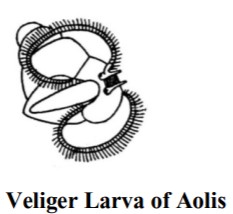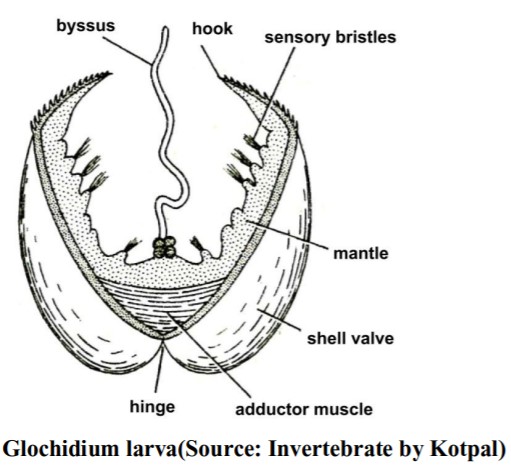LARVAL FORMS OF MOLLUSCA
INTRODUCTION
- Larvae may serve two purposes – finding new settling sites and gaining access to the rich food supply of phytoplankton. The earliest molluscan larva was no doubt a trochophore like that of an annelid. It was a top-shaped creature with a tuft of cilia above and a ciliated band around the middle. This is the only closest resemblence of Mollusca to the Annelida.
- Molluscan life histories do not perfectly correspond with taxonomy, but in general it is true that the archaeogastropods and the bivalves begin life as a trochophore and rapidly pass on to a veliger.
Molluscan Larvae
Veliger Larva
- In this the prototroch is present at anterior side as a pair of ciliated lobes, an arrangement that considerably increases the support given to the larva and makes for a more vigorous and controlled locomotion.
- This development is explained by the advanced stage of differentation reached by the velliger.
- It has something like the form of a mollusca i.e. have a shell, a mantle cavity, a beginnings of the foot and sometime bearing an operculum.
- In the early life of Gastropod there is another complication that is more difficult to explain. This is the torsion which brings the originally posterior mantle cavity to the anterior end and leaves the originally left side of the palial complex on the right.

Glochidium Larva
- Glochidium means the “Point of an arrow”. It is a minute larva, 0.1 to 0.4 mm wide, it is found in the development of pelecypoda or Bivalvia.
- Shell consists of two triangnlar and porous valves, united closely and free ventrally.
- The ventral free end of each valve is produced into a conspicuous hook (curved) bearing spines. The shell encloses the body with the right and left mental lobes. The mantle lobes are very small and their margins bear on each side, three or four groups of peculiar brush like sensory bristles.
- The valves close together by the action of a single massive adductor muscle extending transversely between the two valves.
- The foot is not yet developed but glandular pouch which secretes a long sticky thread called larval byssus. With the help of the byssus it gets attached itself to the skin or gills or fins of a fish and leads a parasitic life for about 15 weeks to get their nourishment from them and live as a ectoparasite on fishes.
- The closure of valves seems to be due to chemical stimulation by salt escaping from the tissues of the fish.
- They soon become encysted by a overgrowth of the skin or mucus membrane of the host. The skin of the fish growing around the glochidium and forms the ‘black head’ and undergoes a peculiar metamorphosis to develop into young adult.

Significance of glochidium larva : –
The life cycle that includes a parasitic glochidium larva on host fishes has many advantages, besides affording protection and a means of nourishment it ensures for wide and more rapid dispersal.
There are different types of molluscan larvae according to the importance of the pelegic phase and amount of planktonic food taken. G. Thorson (1950) recognised three ecological types of larvae in Mollusca.
Planktotrophic larvae with long larval life
- Such larvae have larval life of two or three months e.g. Lamillibranchs, Prosobranchs.
- They are capable of wide distribution.
- They are usually found in tropical, subtropical and a few in high Arctic seas.
- Such molluscan veligers are all ciliary feeders. The large vellar cilia collects particles which are thrown on to a tract at the base of the velum leading to a mouth.
- Coarse or unsuitable particles are removed by rejectory tracts upon the foot.
Planktotrophic larvae with short swimming life
- Such larvae have larval fife of not more than a week in the plankton e.g., Nudibranch larvae, Gibbula cineraria, Hydrobia ulva, Turitella communis and Bela trevelyana. The velum never elaborate.
- Planktonic feeding is of secondary importance. Distribution is the main object or their life.
- There is little growth between hatching and settling.
- Being less dependent on food, they are surprisingly adaptable to unfavourable conditions, and serve mainly for dispersal.
Yolk larvae
- Such larvae take no food in plankton. They are lecithotrophic, as they hatch from very yolky eggs and develop into large, “yolky larvae”.
- They swim little and are passively carried about in the plankton. Gastropods show only few examples of yolk larvae.
- Yolk larvae are normally found in Amphineura, Scaphopoda and protobranchiate Lamillibranchia.
- In Chiton, the yolk larvae are modified egg-shaped trochophores with a broad cilliary ring.
- They spend six hours to few days in the plankton. Neomenia has three such rings, Dentallium four.
- In protobranchs such as Yoldia and Nucula they form a large barrel-shaped ciliated test, which is thrown off when the larva settles

Discover more from ZOOLOGYTALKS
Subscribe to get the latest posts sent to your email.


Pingback: PEARL CULTURE | ZOOLOGYTALKS | 2024